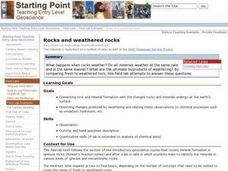Curated OER
Mighty Minerals-We Use Them Everyday
Third graders investigate the importance of knowing about rocks and minerals. They study the way in which many products are produced from rocks and minerals. Students are shown how we obtain many of the rocks and minerals we use.
Curated OER
Mighty Minerals
In this mineral worksheet, students use encyclopedias, the Internet, science catalogs, or magazines to complete research questions about a mineral. Using their research information, they also create a cartoon for their mineral.
Curated OER
Integrating Physical Science and the Geological Environment
Students undertake a series of experiments and activities related to geology, especially in Connecticut. They evaluate types of rocks, minerals, and crystals, exploring the main concepts of geology.
Curated OER
Sediment Sleuths
Are you looking for a good, solid lesson on sedimentary rocks? This one, produced by the Illinois State Museum, is just such a lesson. Middle schoolers identify common rocks and minerals by analyzing sediments from local water sources....
Curated OER
Regolith Formation
Students explain the difference between regolith formation on Earth and the Moon. For this space science lesson, students model the different factors affecting regolith formation on Earth. They identify the different types of weathering.
NOAA
Climate Is Our Friend…Isn’t It?: Make an Extinction Polyhedron
Climate affects populations in different ways. Scholars research extinct organisms and mass extinctions in part three of the 10-installment Discover Your Changing World series. They create graphic organizers, then fill in the information...
Curated OER
It's a Gas! Or is it?
Examine the effects of temperature and pressure on solubility and the states of matter of ocean water. Learners make inferences about the unique chemistry of ocean water at different depths. They engage in an activity related to...
Royal Society of Chemistry
Rock Types 2
All rocks include two or more minerals but greatly vary in appearance. The online interactive encourages scholars to match the rock types to the facts they know about each. They then complete three grid puzzles reviewing the same...
Curated OER
Arkansas State Rock
Here is a lesson plan which shows the value of a mineral called bauxite to Arkansas during the early 1900's. Learners relate the five themes of geography to the history of bauxite and aluminum production in Arkansas. For teachers of...
Curated OER
Igneous Rocks
High schoolers focus on a study of igneous rocks. They see how igneous rocks are formed, and how to distinguish them from other types of rocks. A crystal-growing activity is present, and learners create drawings that show where each...
Curated OER
Moh's Hardness Test
Young geologists utilize Moh's hardness scale to help them correctly sort and classify different types of rocks. This lesson has everything you need, including an excellent example of the Mohs' Hardness Test, to successfully implement...
Curated OER
Rocks Worksheet #2
Topping the page is a chart of crystal size and mineral composition of several different igneous rocks. Geology whizzes answer five multiple choice questions after analyzing the information in the chart. This is a simple, but sufficient...
Curated OER
Life on the Ocean Floor
Why would water 2700 meters deep suddenly become warmer? Explore this and other ocean floor discoveries through this reading response worksheet. Scholars read information about the organisms discovered by Alvin, a deep-sea submersible....
Curated OER
Rocks and Minerals: Sedimentary Rocks
Students explore the concept of rock formation. For this sedimentary rocks lesson, students observe and record their findings about sedimentary rocks. Students then create limestone, coal, and sandstone models and write reports...
Curated OER
Science NetLinks: Fossils and Geologic Time
Students investigate the development of the geologic time scale. Also, to introduce them to the major time periods in earth's history, as well as to the role fossils play in helping us understand this history.
Curated OER
Rocks and weathered rocks
Students connect rock and mineral formation with the changes rocks and minerals undergo at the earth's surface. They observe changes produced by weathering and relating these observations to chemical processes such as oxidation,...
Curated OER
Let's Rock
Students investigate the property of rocks and how to distinguish among the different types. They explore the hardness of rocks and perform streak tests to determine mineral color. They classify rocks according to their properties.
Curated OER
Rockin' Chalk
Fourth graders access prior knowledge of rocks and minerals. In this petroglyphs lesson, 4th graders become familiar with artwork on rocks. Students create original artworks using rock art.
Curated OER
Rock Hounds
Students receive a basis for understanding the three main classifications of rock: igneous, sedimentary and metamorphic. They engage in a hands-on activity designed to give them an appreciation for rocks and minerals.
Curated OER
The Story of Rocks
In this science worksheet, learners learn to classify rocks as igneous, sedimentary or metamorphic. Students learn what a mineral is and the stages of the rock cycle. Learners experiment with samples of 7 minerals and record data on...
Curated OER
Regolith Formation
Students study what regolith is and how it contrasts with weathering on Earth. In this weathering instructional activity students divide into groups, hypothesize and confirm their guesses.
Curated OER
The Color of Soil
Students are introduced to the Munsell System of Color Notation that is used for direct comparison of soils anywhere in the world. They become familiar with hue, value and chroma notations, identify colors that act as clues to the...
Curated OER
Computer Lab Lesson Plan - Science
Students examine rocks and minerals. Using the internet, students research rocks and how they are formed. They use word processing software to list minerals and materials that form specific rocks.
Curated OER
Minerals
Students explore the world of minerals. They classify minerals into their protective categories. Students analyze minerals with their different colors, textures and components. They bring in an example of a mineral to class to share with...

























